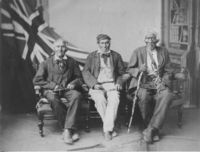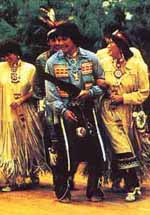
The Northeast: The Seneca People of the Iroquois Confederacy
In the following pages, you will be introduced to the two different traditional song styles, intertribal music, and dance styles of the Northeast and Southwest.
New York State, the Canadian province of Ontario, Green Bay (Wisconsin), and northeastern Oklahoma are all home to members of the Six Nations of the Iroquois Confederacy, also known as the Haudenosaunnee. This confederacy, made up of the Onondaga, Seneca, Cayuga, Oneida, Mohawk, and Tuscarora nations, was the dominant regional power in New York State and Northern Pennsylvania before the American Revolution.

Iroquois Nation in 1914
In fact, large parts of the American constitution were modeled upon the Iroquoian system of government, especially the concept of semi-independent states within a larger federal government. Now scattered on reserves and reservations across two countries, the political structure and religious beliefs of these people-known as the "Great Law"-has enabled their way of life to survive and prosper.
Because Iroquoian people live in geographically far-flung communities, they have created a means for tribal members to gather twice a year in what are known as "Sings," a series of music contests that rotate around the various reserves and reservations. These Sings feature performances in a musical genre known as Eskanyeh Ganiseh or "Women's social dance songs." Part of the larger Iroquoian musical category called "Earth Songs," Eskanyeh are danced ONLY by women, but may be sung by both women and men at Sings.

Iroquois Confederacy, Mohawk Leaders
Song texts may be old or newly made, and include words in English and/or Seneca, plus vocables. Seneca is the only native language used, because it considered the most pleasing language to the ear of the various Iroquoian languages. Interestingly enough, Eskanyeh song texts can include bits and pieces of popular songs (especially country music songs), adapted into the Eskanyeh style.

Iroquois Festival
Iroquoian social dance music uses repetitive verse forms, with cadence patterns made up of vocables completing each larger phrase unit.
The listening example below is an Eskanyeh titled "Ho Way Hey Yo", sung by the Six Nations Women's Singing Society of the Six Nations Reserve near Brantford, Ontario. Eskanyeh is usually performed in sets of seven songs, with each song being repeated twice (you will hear the listening example only once). The singers sit in two rows facing each other, and the lead singer plays a small water drum, while the others play cow-horn rattles.
Composer: Anonymous
-
"Ho Way Hey Yo (Eskanyeh)"
Composer: Anonymous
-
"Ho Way Hey Yo (Eskanyeh)" [ 00:00-00:12 ]00:11
Introduction: Water drum and rattles, slow to fast
Composer: Anonymous
-
"Ho Way Hey Yo (Eskanyeh)" [ 00:12-00:26 ]00:15
Voices begin: Heeeeeeeee-ya...
A: Solo with duple beat drum and rattles--cadence
Composer: Anonymous
-
"Ho Way Hey Yo (Eskanyeh)" [ 00:27-00:39 ]00:13
A1: Group repeats solo (rattles long tone), beat picks up--cadence
Composer: Anonymous
-
"Ho Way Hey Yo (Eskanyeh)" [ 00:40-00:56 ]00:17
B: Group with steady beat--cadence
Composer: Anonymous
-
"Ho Way Hey Yo (Eskanyeh)" [ 00:57-01:09 ]00:12
A1: Group repeats solo (rattles long tone), beat picks up--cadence
Composer: Anonymous
-
"Ho Way Hey Yo (Eskanyeh)" [ 01:09-01:17 ]00:07
B1: Group with steady beat--no cadence
Composer: Anonymous
-
"Ho Way Hey Yo (Eskanyeh)" [ 01:16-01:35 ]00:18
B2: Group with steady beat, then Hai-ii with voices rising
Singing societies are benevolent organizations, and the members donate whatever profits they make from singing to charity. Although the Six Nations Women's Singing Society is all-female, all-male groups predominate. Singing societies come together twice as year for Sings, where they perform their new songs and old favorites for an appreciative audience of dancers. As a women's social dance, Eskanyeh is danced only by women (although men can and do sing the songs) and is a group freeform-style dancing, where an individual follows a leader but still has a degree of freedom to improvise.





Competition singing, known as Inuit throat singing, was done by both men and women in the Northwest Coast and among Inuit and other Arctic peoples.




